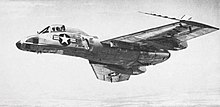Chance Vought F7U
| Vought F7U Cutlass | |
|---|---|
 F7U-3M of Squadron VF-83, USS Intrepid , 1954 |
|
| Type: | Fighter plane |
| Design country: | |
| Manufacturer: | |
| First flight: |
September 29, 1948 |
| Commissioning: |
1954 |
| Production time: |
1950 to 1955 |
| Number of pieces: |
305 to 325 |
The Vought F7U Cutlass (dt. Cutlass ) was a jet powered fighter aircraft of the US Navy from the early Cold War .
development
In 1946 the Navy ordered three prototypes. The first aircraft made its maiden flight on September 29, 1948.
Vought received the building contract for 14 F7U-1s, which corresponded to the prototypes, as well as for the F7U-2 (which was never built due to engine problems) and the F7U-3, which was built as the final version in 180 copies. 98 of these machines were equipped as F7U- 3Ms for the use of AIM-7 Sparrow air-to-air missiles.
construction
The design of the Cutlass as a tailless aircraft was unusual. Comparisons were made with the Arado draft E. 583 (Project I); However, the head of the aerodynamic research department at Vought, William C. Schoolfield, has denied that there was any orientation towards German research results.
The F7U did not have a horizontal stabilizer, only large curved wings with two small vertical stabilizers. The roll and pitch control was guaranteed by Elevons .
It was powered by two Westinghouse J46 WE 8A turbo jets, each with 20.5 kN of thrust.
Served as armament four 20-mm automatic cannon .
Versions
Production figures according to Winchester, deviating figures in brackets according to Andrade
- XF7U-1
- Prototypes, 3 built, with Westinghouse J34 WE-22 engines
- F7U-1
- Series version, 14 (20) built and used as an advanced trainer
- F7U-2
- Version with Westinghouse J34 W 42 engines, order for 88 machines has been canceled
- F7U-3
- Constructively heavily modified version with new fuselage bow, with Westinghouse J46 WE-8 engines, 178 (192) built, 2 canceled
- F7U-3M
- F7U-3 capable of firing four Sparrow-I air-to-air missiles; 50 newly built and 48 F7U-3 cells upgraded to this standard, 202 machines canceled
- F7U-3P
- Armed scout with cameras in the fuselage, 12 built, 2 canceled
production
Acceptance of the Chance-Vought Cutlass by the US Navy:
| version | 1949 | 1950 | 1951 | 1952 | 1953 | 1954 | 1955 | TOTAL |
|---|---|---|---|---|---|---|---|---|
| XF7U-1 | 2 | 1 | 6th | 9 | ||||
| F7U-1 | 4th | 3 | 1 | 8th | ||||
| F7U-3 | 10 | 68 | 92 | 170 | ||||
| F7U-3K | 17th | 39 | 56 | |||||
| F7U-3M | 42 | 42 | ||||||
| F7U-3P | 6th | 6th | 12 | |||||
| TOTAL | 2 | 5 | 9 | 11 | 68 | 115 | 87 | 297 |
Technical specifications
| Parameter | F7U-3 data |
|---|---|
| crew | 1 |
| length | 13.49 m |
| span | 11.79 m |
| height | 4.27 m |
| Empty mass | 6,005 kg |
| Max. Takeoff mass | 14,383 kg |
| Top speed | 1,088 km / h |
| Service ceiling | 12,195 m |
| Rate of climb | 3,693 m / min |
| Range | 1,056 km |
| Engines | two turbojets Westinghouse J46-WE-8A with 20.5 kN each |
| Armament | four 20-mm automatic cannon |
See also
Web links
Individual evidence
- ↑ Jim Winchester: F7U Cutlass. International Air Power Review, Vol. 15, p. 100
- ^ Jim Winchester: International Air Power Review. Vol. 15.
- ↑ John M. Andrade: US Military Aircraft Designations and Serials since 1909. 1979, p. 192 f.
- ↑ Statistical Digest of the USAF 1949, p. 164 ff .; 1951, p. 153 ff .; 1952, p. 153 ff .; 1953, p. 185; 1954, p. 70; 1955, p. 80




